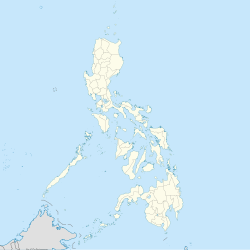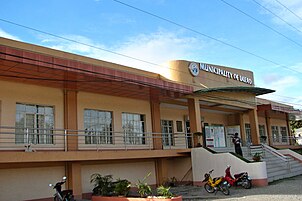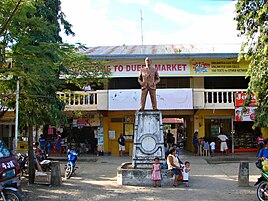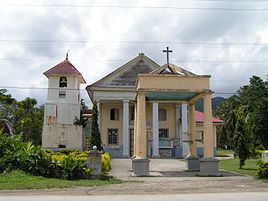Duero, Bohol: Difference between revisions
Appearance
Content deleted Content added
m →top: clean up |
No edit summary |
||
| Line 108: | Line 108: | ||
It may have been named after the [[Douro]] (Duero) in the [[Iberian peninsula]]. Roman Catholicism was introduced to the town in 1860 by a Spanish priest. Duero was established as a municipality two years later, and a convent was constructed in 1868.<ref name=boholgov/> |
It may have been named after the [[Douro]] (Duero) in the [[Iberian peninsula]]. Roman Catholicism was introduced to the town in 1860 by a Spanish priest. Duero was established as a municipality two years later, and a convent was constructed in 1868.<ref name=boholgov/> |
||
The town of Duero, Bohol celebrates its fiesta on December 10, to honor the town patron Immaculate Conception.<ref> {{cite web| url = https://www.bohol-philippines.com/bohol-festivals-and-feast-days.html | title = ''Bohol Festivals Timetable'' |
|||
| publisher = "www.bohol-philippines.com"| accessdate=2019-03-07}} </ref> |
|||
==Barangays== |
==Barangays== |
||
Revision as of 10:24, 7 March 2019
Duero | |
|---|---|
| Municipality of Duero | |
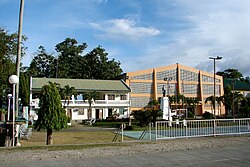 Duero | |
 Map of Bohol with Duero highlighted | |
Location within the Philippines | |
| Coordinates: 9°43′N 124°24′E / 9.72°N 124.4°E | |
| Country | |
| Region | Central Visayas |
| Province | Bohol |
| District | 3rd District |
| Founded | 1862 |
| Barangays | 21 (see Barangays) |
| Government | |
| • Type | Sangguniang Bayan |
| • mayor of Duero[*] | Connie Amparo |
| • Vice Mayor | Emma Bajade |
| • Congressman | Arthur Yap |
| • Electorate | 14,109 voters (2022) |
| Area | |
• Total | 97.30 km2 (37.57 sq mi) |
| Population (2020 census)[3] | |
• Total | 18,861 |
| • Density | 190/km2 (500/sq mi) |
| Time zone | UTC+8 (PST) |
| ZIP code | 6309 |
| PSGC | |
| IDD : area code | +63 (0)38 |
| Income class | 4th municipal income class |
| Revenue (₱) | ₱ 96.54 million (2020), 43.75 million (2012), 47.79 million (2013), 54.36 million (2014), 60.56 million (2015), 66.57 million (2016), 77.48 million (2017), 88.84 million (2018), 85.95 million (2019), 102.2 million (2021), 137.2 million (2022) |
| Native languages | Boholano dialect Cebuano Eskayan Tagalog |
Duero, officially the Municipality of Duero, (Template:Lang-ceb; Template:Lang-tgl), is a 4th class municipality in the province of Bohol, Philippines. According to the 2020 census, it has a population of 18,861 people.[3]
It may have been named after the Douro (Duero) in the Iberian peninsula. Roman Catholicism was introduced to the town in 1860 by a Spanish priest. Duero was established as a municipality two years later, and a convent was constructed in 1868.[4]
The town of Duero, Bohol celebrates its fiesta on December 10, to honor the town patron Immaculate Conception.[5]
Barangays
Duero comprises 21 barangays:
| PSGC | Barangay | Population | ±% p.a. | |||
|---|---|---|---|---|---|---|
| 2020[3] | 2010[6] | |||||
| 071221001 | Alejawan | 4.1% | 773 | 801 | −0.36% | |
| 071221002 | Angilan | 2.7% | 514 | 540 | −0.49% | |
| 071221003 | Anibongan | 2.5% | 479 | 540 | −1.19% | |
| 071221004 | Bangwalog | 7.2% | 1,358 | 1,340 | 0.13% | |
| 071221005 | Cansuhay | 4.2% | 789 | 735 | 0.71% | |
| 071221006 | Danao | 3.4% | 646 | 688 | −0.63% | |
| 071221007 | Duay | 2.6% | 482 | 390 | 2.14% | |
| 071221008 | Guinsularan | 9.0% | 1,689 | 1,736 | −0.27% | |
| 071221020 | Imelda | 3.2% | 603 | 615 | −0.20% | |
| 071221009 | Itum | 6.0% | 1,135 | 1,139 | −0.04% | |
| 071221010 | Langkis | 7.1% | 1,338 | 1,002 | 2.93% | |
| 071221011 | Lobogon | 5.8% | 1,103 | 1,329 | −1.85% | |
| 071221012 | Madua Norte | 2.7% | 515 | 475 | 0.81% | |
| 071221013 | Madua Sur | 3.9% | 731 | 699 | 0.45% | |
| 071221014 | Mambool | 3.2% | 607 | 556 | 0.88% | |
| 071221015 | Mawi | 2.8% | 523 | 518 | 0.10% | |
| 071221016 | Payao | 3.4% | 639 | 598 | 0.67% | |
| 071221017 | San Antonio (Poblacion) | 6.3% | 1,181 | 1,211 | −0.25% | |
| 071221018 | San Isidro | 4.3% | 816 | 809 | 0.09% | |
| 071221019 | San Pedro | 7.8% | 1,467 | 1,334 | 0.95% | |
| 071221021 | Taytay | 3.2% | 611 | 525 | 1.53% | |
| Total | 18,861 | 17,580 | 0.71% | |||
Demographics
| Year | Pop. | ±% p.a. |
|---|---|---|
| 1903 | 6,853 | — |
| 1918 | 8,314 | +1.30% |
| 1939 | 9,272 | +0.52% |
| 1948 | 8,939 | −0.41% |
| 1960 | 8,929 | −0.01% |
| 1970 | 9,965 | +1.10% |
| 1975 | 11,522 | +2.95% |
| 1980 | 11,619 | +0.17% |
| 1990 | 14,242 | +2.06% |
| 1995 | 14,299 | +0.07% |
| 2000 | 16,485 | +3.10% |
| 2007 | 17,254 | +0.63% |
| 2010 | 17,580 | +0.68% |
| 2015 | 17,876 | +0.32% |
| Source: Philippine Statistics Authority[7][6][8][9] | ||
Gallery
-
Duero town hall
-
Public market
-
Church
References
- ^ Municipality of Duero | (DILG)
- ^ "Province: Bohol". PSGC Interactive. Quezon City, Philippines: Philippine Statistics Authority. Retrieved 12 November 2016.
- ^ a b c Census of Population (2020). "Region VII (Central Visayas)". Total Population by Province, City, Municipality and Barangay. Philippine Statistics Authority. Retrieved 8 July 2021.
- ^ "Municipality of Duero". Retrieved 30 January 2015.
- ^ "Bohol Festivals Timetable". "www.bohol-philippines.com". Retrieved 2019-03-07.
- ^ a b Census of Population and Housing (2010). "Region VII (Central Visayas)" (PDF). Total Population by Province, City, Municipality and Barangay. National Statistics Office. Retrieved 29 June 2016.
- ^ Census of Population (2015). "Region VII (Central Visayas)". Total Population by Province, City, Municipality and Barangay. Philippine Statistics Authority. Retrieved 20 June 2016.
- ^ Censuses of Population (1903–2007). "Region VII (Central Visayas)". Table 1. Population Enumerated in Various Censuses by Province/Highly Urbanized City: 1903 to 2007. National Statistics Office.
- ^ "Province of Bohol". Municipality Population Data. Local Water Utilities Administration Research Division. Retrieved 17 December 2016.
Wikimedia Commons has media related to Duero.

